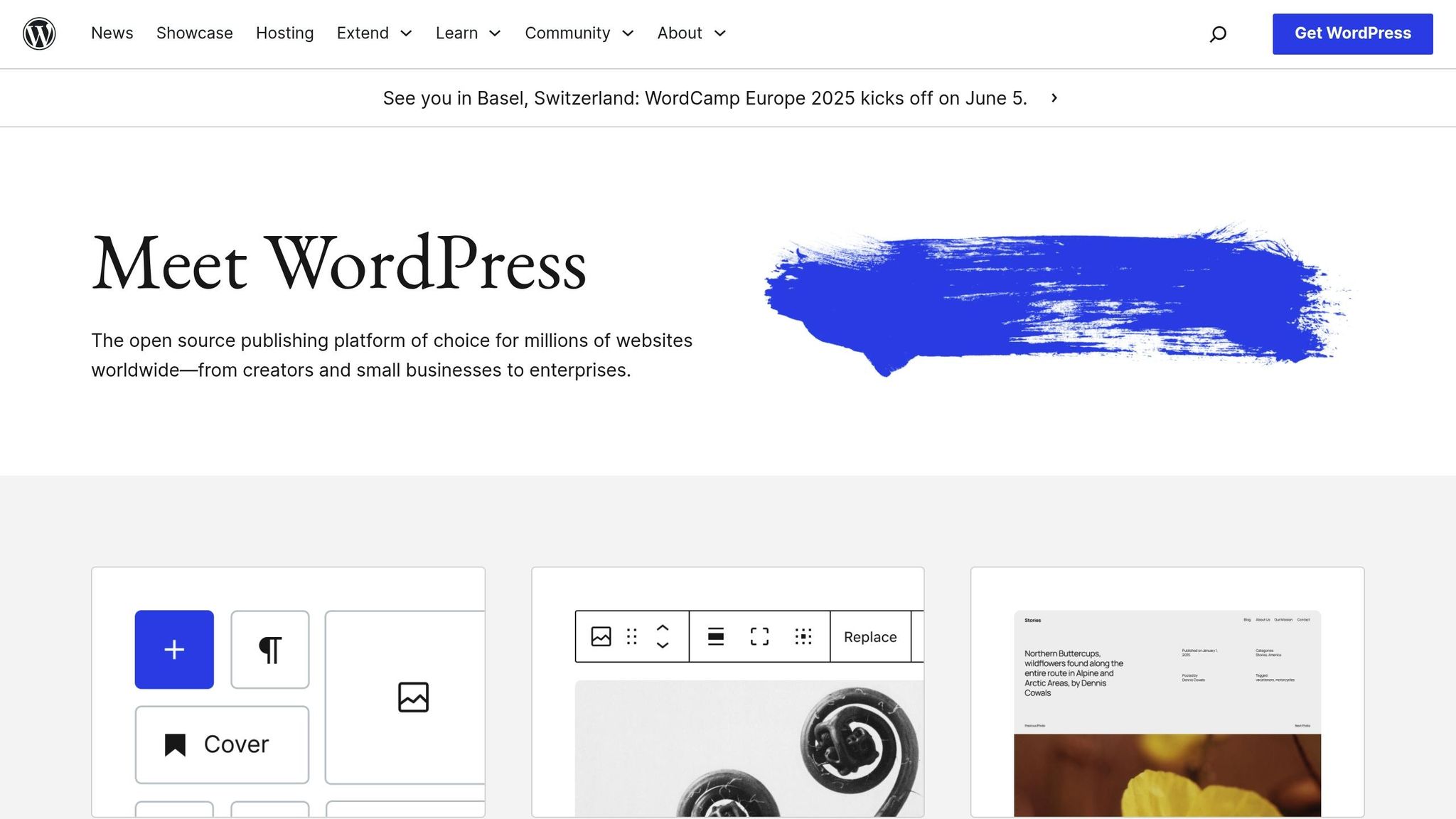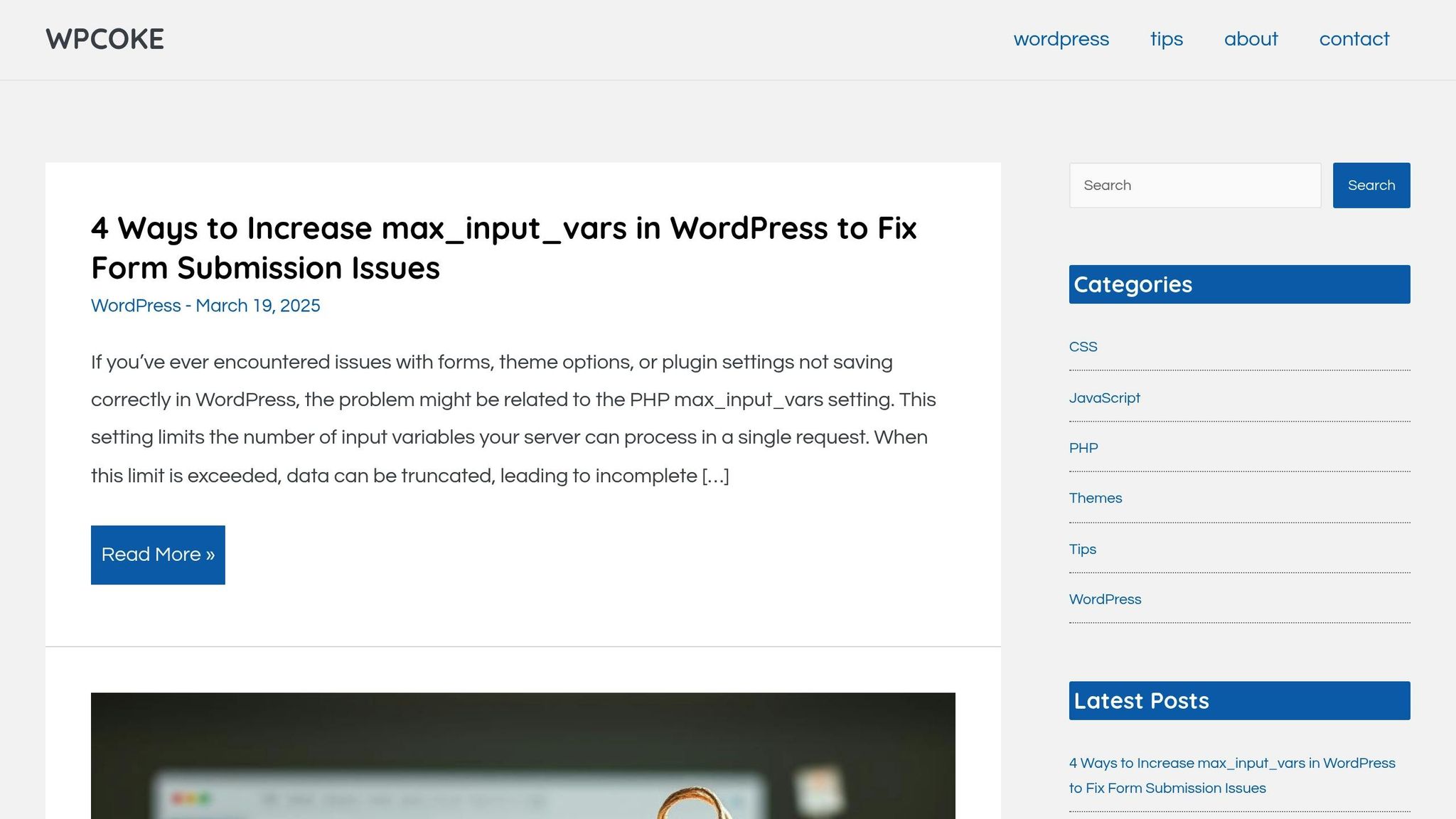The WordPress White Screen of Death (WSOD) is a frustrating issue where your site displays a blank white page with no error messages. It usually happens due to plugin conflicts, theme errors, or memory limits. Here’s how you can fix it quickly:
- Deactivate Plugins: Rename the
pluginsfolder via FTP to disable all plugins at once. - Switch Theme: Change to a default WordPress theme like Twenty Twenty-Three using FTP.
- Increase PHP Memory: Edit
wp-config.phpto setdefine('WP_MEMORY_LIMIT', '256M');. - Enable Debug Mode: Turn on debugging in
wp-config.phpto locate errors. - Clear Caches: Delete browser, server, and plugin caches.
- Restore Backup: Revert your site to a previous working version.
To prevent WSOD in the future:
- Keep WordPress, plugins, and themes updated.
- Test changes in a staging environment.
- Regularly back up your site.
If all else fails, tools like WPCOKE offer automated backups, plugin management, and performance optimization to keep your site running smoothly.
How to Fix the WordPress White Screen of Death (Step by Step)

What Causes the White Screen of Death
The WordPress White Screen of Death (WSOD) often stems from problems with plugins or themes. Pinpointing the root cause is the first step to resolving it.
Plugin Issues
Plugins are a frequent culprit behind WSOD. Problems can arise when:
- A plugin’s code clashes with WordPress core files.
- Outdated or poorly coded plugins cause errors.
- Plugins don’t work with your current WordPress version.
Sometimes, these conflicts can even lock you out of the admin dashboard. But plugins aren’t the only potential source of trouble – theme errors can also lead to WSOD.
Theme Problems
Themes can trigger WSOD, particularly if there are mistakes in critical files like functions.php. Common theme-related issues include:
- PHP syntax errors.
- Coding mistakes such as missing semicolons or brackets in custom code.
- Conflicts between theme functions and your WordPress version.
If you think the theme is the problem, try switching to a default WordPress theme like Twenty Twenty-Three to see if the issue persists.
6 Steps to Fix White Screen Issues
Here’s a step-by-step guide to help you resolve white screen problems on your WordPress site.
Turn Off All Plugins
Start by deactivating all plugins. If you can’t access the Dashboard, use FTP to rename the plugins folder:
- Navigate to
wp-content/pluginsusing FTP. - Rename the folder to
plugins_old. - Check if your site is working.
- If it does, reactivate plugins one at a time to find the problematic one.
Switch to a Default WordPress Theme
Change your active theme to a default WordPress theme like Twenty Twenty-Three. Use FTP for this:
- Go to
wp-content/themes. - Download the Twenty Twenty-Three theme from WordPress.org.
- Upload it to the themes folder.
- Rename your current theme’s folder.
- WordPress will automatically switch to the default theme.
Increase PHP Memory
If your site is running out of memory, increase the PHP memory limit by editing the wp-config.php file:
- Locate the
wp-config.phpfile via FTP. - Add this line before the comment
/* That's all, stop editing! */:
define('WP_MEMORY_LIMIT', '256M'); - Save the file and refresh your site.
Enable Debug Mode
Turn on WordPress debug mode to identify errors:
- Open the
wp-config.phpfile. - Add these lines to enable debugging:
define('WP_DEBUG', true); define('WP_DEBUG_LOG', true); define('WP_DEBUG_DISPLAY', true); - Save the file and check the
wp-content/debug.logfile for error details.
Clear All Caches
Clearing caches can resolve conflicts caused by outdated files:
- Clear your browser cache.
- Delete server-side caches, including:
- Files in
wp-content/cache/ - Hosting provider’s cache
- CDN caches
- Files in
- Temporarily disable caching plugins.
Restore a Backup
If all else fails, restore your site using a backup. Be sure to back up your current site first:
- Download your most recent backup files.
- Back up your current site for safety.
- Replace the
wp-contentfolder and database with the backup versions. - Test your site to ensure it’s working.
- Re-add any new content created after the backup.
sbb-itb-f80d703
How to Prevent White Screens
Avoid WSOD (White Screen of Death) by following these practical strategies. These tips work alongside the earlier step-by-step fixes.
Keep WordPress Updated
Keeping WordPress core, themes, and plugins up to date is key to maintaining site stability. Here’s how to stay on top of updates:
- Check for updates every week.
- Apply security patches as soon as they’re available.
- Update plugins during off-peak hours to minimize disruptions.
- Keep a log of all updates for future reference.
Pro Tip: Test all updates in a staging environment first. This step helps you spot conflicts or issues before they impact your live site.
Make Regular Backups
Back up everything – WordPress files, media, and databases. Store your backups in an external location for added security. For business websites, aim for daily backups. For personal blogs, weekly backups should suffice.
Test Changes Before Going Live
Before making changes to your live site, test new plugins, themes, or custom code in a staging environment. This precaution helps you catch conflicts or performance problems early.
Monitor Server Health
Keep an eye on your server’s resources to ensure smooth operation:
| Resource | Check Frequency | Warning Signs |
|---|---|---|
| CPU Usage | Daily | Consistently above 80% usage |
| Memory Usage | Daily | Approaching PHP memory limits |
| Disk Space | Weekly | Less than 20% free space |
| Database Size | Monthly | Sudden, unexplained size increases |
Regular monitoring can help you catch and address server issues before they cause downtime.
Keep a Detailed Change Log
Document every change you make to your site. Include:
- Dates of updates
- Version numbers
- Configuration changes
- New plugin installations
- Custom code edits
A well-maintained log can save you time when troubleshooting, making it easier to pinpoint recent changes that could be causing issues.
WPCOKE Help Tools

WPCOKE provides a range of tools to diagnose, resolve, and prevent the White Screen of Death on WordPress sites. These solutions are designed to quickly get your site back on track and safeguard it from future problems. Here’s how WPCOKE can help:
Fix-It Guides
Our troubleshooting guides address common WordPress issues step by step. Here’s what they include:
| Guide Type | Features | Benefits |
|---|---|---|
| Plugin Diagnostics | Detects plugin conflicts | Avoids risky updates |
| Theme Compatibility | Tests themes for errors | Pinpoints theme-related problems |
| Memory Management | Adjusts PHP limits | Fixes resource-related issues |
With tools like the Smart Plugin Manager, WPCOKE ensures your plugins are updated safely. If an update causes issues, it can automatically roll back changes to keep your site running smoothly.
Backup Instructions
WPCOKE’s backup system protects your site as you troubleshoot. Key features include:
- Automated nightly backups stored for 30 days
- Instant restoration to recover your site with ease
This system ensures your data is secure and easily retrievable when needed.
Speed Tips
Improve your site’s performance and minimize potential issues with WPCOKE’s optimization tools. These features include:
- Fine-tuning wp-config.php for better performance without compromising security
- Quick PHP memory limit adjustments by our support team to fix memory-related errors
- Built-in plugin compatibility checks with instant rollback options to prevent downtime
Conclusion
The WordPress White Screen of Death (WSOD) can be resolved with a step-by-step approach. By identifying common causes – like plugin conflicts, theme errors, or memory limits – you can address the issue and get your site back online.
"If you run into problems on your site, including the white screen of death, backups will be your best friend. If you have one on hand, you can quickly restore it and get your site up and running exactly how it was before the problem occurred." – Donna Fontenot
To minimize the risk of WSOD, focus on keeping your site updated, managing memory effectively, and testing changes in a controlled environment. Tools like WPCOKE’s Smart Plugin Manager, Nightly Backups, and Performance Tools can provide added protection.
Here’s how WPCOKE supports site maintenance:
| Tool | Key Feature |
|---|---|
| Smart Plugin Manager | Automatically rolls back changes |
| Nightly Backups | Retains backups for 30 days |
| Performance Tools | Adjusts PHP memory limits |
Always use a staging environment before implementing updates or changes. Pairing this with WPCOKE’s diagnostic tools and backup systems creates a solid plan for maintaining your WordPress site and avoiding future WSOD headaches. These strategies build on the earlier steps, offering a reliable way to keep your site running smoothly.
FAQs
What can I do if disabling plugins and changing themes doesn’t fix the WordPress White Screen of Death?
If disabling plugins and switching themes doesn’t resolve the WordPress White Screen of Death (WSOD), the next step is to increase your PHP memory limit. To do this, edit the wp-config.php file by adding the following line:
define('WP_MEMORY_LIMIT', '256M'); If increasing the memory limit doesn’t solve the issue, enable debugging mode in WordPress to identify the root cause. Add this line to your wp-config.php file:
define('WP_DEBUG', true); This will display error messages that can help pinpoint what’s causing the problem. If these steps still don’t work, consider restoring your site from a recent backup to minimize downtime.
How can I safely update my WordPress site to avoid the White Screen of Death in the future?
To avoid the WordPress White Screen of Death (WSOD) when making updates, always start by creating a full backup of your site. This ensures you can restore your site if anything goes wrong.
For safer testing, consider using a staging environment to test updates to plugins, themes, or WordPress core before applying them to your live site. If a staging site isn’t an option, update plugins and themes one at a time, checking your site after each change to identify potential issues.
Additionally, enable debugging mode in WordPress to catch any errors during the update process. This will help you pinpoint the source of problems and address them quickly, minimizing downtime.
How can WPCOKE tools help with WordPress backups and optimizing site performance?
WPCOKE tools provide an easy and reliable way to manage WordPress backups and improve site performance. With automated backup options, you can safeguard your website data and restore it quickly in case of unexpected issues. These tools also help optimize your site’s performance by identifying and resolving common bottlenecks, ensuring faster load times and a better user experience.
By using WPCOKE, you can reduce downtime, enhance site stability, and maintain smoother operations, all while saving time with user-friendly features tailored for WordPress.
